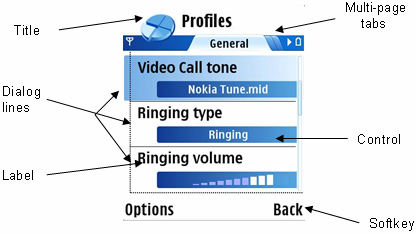
Figure 1: Dialog terminology
Dialogs are UI elements used by GUI applications.

Figure 1: Dialog terminology
As shown in Figure 1, a dialog consists of a title, zero or more pages consisting of a sequence of lines, and a row of one or more softkeys (CBA).
The lines can only be arranged vertically, allowing for simpler programming, a small application footprint, and a high likelihood of dialogs that are easy for novice users to use. Each line consists of a label and a control for displaying and entering data. The controls are: a choice list, a set of option buttons, a check box, and input fields. Most dialogs have one page of controls.
Multi-page tabs only appear in multi-page dialogs. They are used to access separate dialog pages. When a lot of controls are put together on a single dialog, a multi-page dialog (or occasionally a scrolling dialog) is invariably used to fit all the controls neatly on devices’ small screens. There is a difference between multi-page tabs with dialog architecture and multi-views with view architecture. In views, the view state and data need to be saved between the switch, and each view can be activated from outside by a view-switch mechanism, whereas in multi-page dialogs data is saved when the dialog is closed (after memory footprint) and it is not possible to reach individual dialog tabs from outside the dialog.
For typical dialog uses, S60 provides a large collection of ready-made dialog classes.
S60 3.1 Queries API Specification for more information.
S60 3.1 Notifiers API Specification for more information.
S60 3.1 Notes API Specification for more
information.
S60 3.1 Form API Specification for more
information.
This document describes how to implement and use dialogs.
For further information see API documentation for CEikDialog in Symbian
OS 9.1 API Reference Guide for more information.
This API is valid for all platforms running on Symbian OS 9.1 or later.
Dialogs API is an SDK API and was first published in S60 release 0.9.